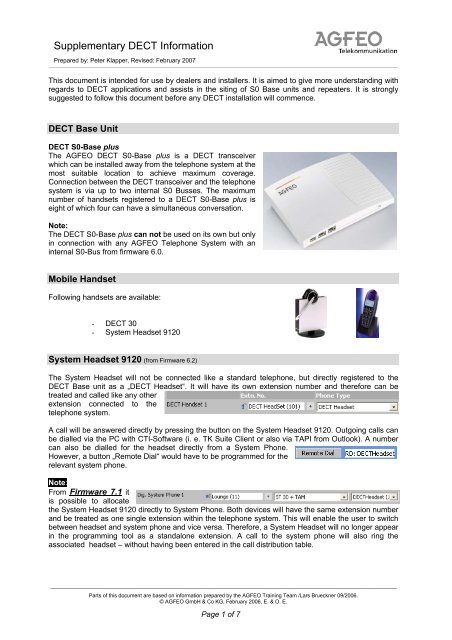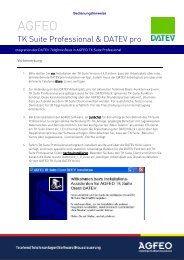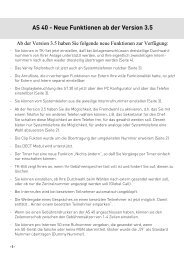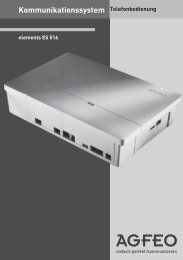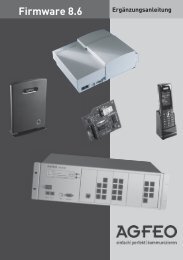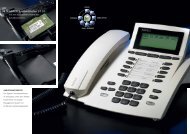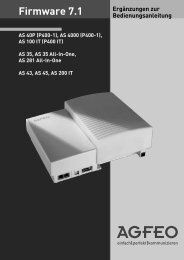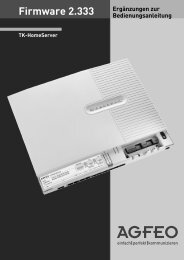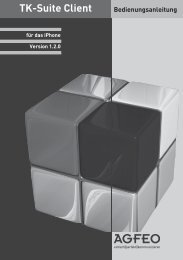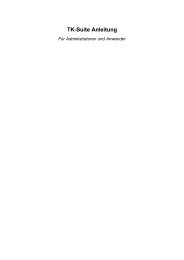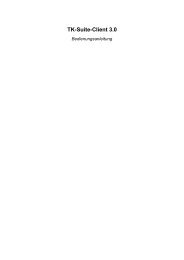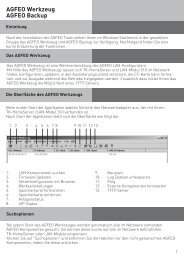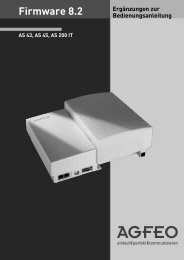Create successful ePaper yourself
Turn your PDF publications into a flip-book with our unique Google optimized e-Paper software.
Supplementary <strong>DECT</strong> Information<br />
Prepared by: Peter Klapper, Revised: February 2007<br />
_______________________________________________________________________________________________________________________________________________________________________________________________________________<br />
This document is intended for use by dealers and installers. It is aimed to give more understanding with<br />
regards to <strong>DECT</strong> applications and assists in the siting of S0 <strong>Base</strong> units and repeaters. It is strongly<br />
suggested to follow this document before any <strong>DECT</strong> installation will commence.<br />
<strong>DECT</strong> <strong>Base</strong> <strong>Unit</strong><br />
<strong>DECT</strong> S0-<strong>Base</strong> plus<br />
The AGFEO <strong>DECT</strong> S0-<strong>Base</strong> plus is a <strong>DECT</strong> transceiver<br />
which can be installed away from the telephone system at the<br />
most suitable location to achieve maximum coverage.<br />
Connection between the <strong>DECT</strong> transceiver and the telephone<br />
system is via up to two internal S0 Busses. The maximum<br />
number of handsets registered to a <strong>DECT</strong> S0-<strong>Base</strong> plus is<br />
eight of which four can have a simultaneous conversation.<br />
Note:<br />
The <strong>DECT</strong> S0-<strong>Base</strong> plus can not be used on its own but only<br />
in connection with any AGFEO Telephone System with an<br />
internal S0-Bus from firmware 6.0.<br />
Mobile Handset<br />
Following handsets are available:<br />
- <strong>DECT</strong> 30<br />
- System Headset 9120<br />
System Headset 9120 (from Firmware 6.2)<br />
The System Headset will not be connected like a standard telephone, but directly registered to the<br />
<strong>DECT</strong> <strong>Base</strong> unit as a „<strong>DECT</strong> Headset“. It will have its own extension number and therefore can be<br />
treated and called like any other<br />
extension connected to the<br />
telephone system.<br />
A call will be answered directly by pressing the button on the System Headset 9120. Outgoing calls can<br />
be dialled via the PC with CTI-Software (i. e. TK Suite Client or also via TAPI from Outlook). A number<br />
can also be dialled for the headset directly from a System Phone.<br />
However, a button „Remote Dial“ would have to be programmed for the<br />
relevant system phone.<br />
Note:<br />
From Firmware 7.1 it<br />
is possible to allocate<br />
the System Headset 9120 directly to System Phone. Both devices will have the same extension number<br />
and be treated as one single extension within the telephone system. This will enable the user to switch<br />
between headset and system phone and vice versa. Therefore, a System Headset will no longer appear<br />
in the programming tool as a standalone extension. A call to the system phone will also ring the<br />
associated headset – without having been entered in the call distribution table.<br />
_____________________________________________________________________________________________________________________<br />
Parts of this document are based on information prepared by the AGFEO Training Team /Lars Brueckner 09/2006.<br />
© AGFEO GmbH & Co KG, February 2006, E. & O. E.<br />
Page 1 of 7
Supplementary <strong>DECT</strong> Information<br />
Prepared by: Peter Klapper, Revised: February 2007<br />
_______________________________________________________________________________________________________________________________________________________________________________________________________________<br />
System Functions<br />
The professional <strong>DECT</strong> 30 cordless handset will offer the following selected features:<br />
- Easy access to the central Telephone Book<br />
- Caller ID (CLIP) see who is calling before you answer<br />
- Programmable Function Buttons<br />
- CTI-Utilisation (TAPI, TK Suite Client etc.)<br />
- Global Call Log<br />
- Remote Dial without pressing Call Button<br />
- BLF for Busy Lines and Extensions<br />
- Message received notification from Answering Machine Module<br />
- Missed Call Log<br />
- Programmable Charging Cradle Event Manager<br />
- Independent Phone Book<br />
- Headset Connection<br />
- Vibration Alert<br />
- Auto Answer Mode<br />
- Signal Strength Metering Mode (Engineering)<br />
<strong>DECT</strong> Signal Suppression<br />
The transmission of a radio signal is subject to physical factors and conditions of the surrounding area.<br />
Site specific conditions will greatly affect the <strong>DECT</strong> coverage of the installation.<br />
100 %<br />
The range will greatly depend on the siting of the <strong>DECT</strong> <strong>Base</strong> plus unit within its surrounding area.<br />
Obstacles between the transceiver and <strong>DECT</strong> handset will affect the overall performance and reduce<br />
the range of the unit. For this reason it is strongly suggested to carry out a site survey and a <strong>DECT</strong><br />
transmission metering (see below) before commencing any installation. Only then can a satisfactory<br />
operation be guaranteed.<br />
Radio waves will be affected by the following:<br />
Plants, partitions, wodden facia with standard windows<br />
Brick walls with standard windows 10 db<br />
Brick walls with special windows for isolation, metal coated<br />
Reinforced concrete wall & ceiling, depending on thickness<br />
Metal glass facia, with triple glass windows<br />
Metal facia with no windows<br />
Reinforced Concrete, Plasterboard, Wooden Frameworks, Metal Coated<br />
Glass in Windows, Aluminium Foils use by insulation materials and<br />
underfloor heating.<br />
It should also be taken into consideration that radio waves will be reflected as a direct result of the<br />
above materials.<br />
_____________________________________________________________________________________________________________________<br />
Parts of this document are based on information prepared by the AGFEO Training Team /Lars Brueckner 09/2006.<br />
© AGFEO GmbH & Co KG, February 2006, E. & O. E.<br />
Page 2 of 7<br />
5 db<br />
20 db<br />
23 db<br />
25 db<br />
40 db<br />
30 %<br />
10 %<br />
1%<br />
0.5 %<br />
0.25 %<br />
0.01%
Supplementary <strong>DECT</strong> Information<br />
Prepared by: Peter Klapper, Revised: February 2007<br />
_______________________________________________________________________________________________________________________________________________________________________________________________________________<br />
Expanding the Coverage Area (using Repeaters)<br />
The range of the <strong>DECT</strong> S0 <strong>Base</strong> can be expanded by using repeaters. The maximum number of<br />
repeaters which can be connected to a <strong>DECT</strong> S0 <strong>Base</strong> is six. Repeaters can not only be installed in a<br />
circular arrangement around the <strong>Base</strong> unit but also be cascaded in a line. In the latter and in theory<br />
distances of up to 1 km can be covered. For the cascading installation of repeaters a special „<strong>DECT</strong>-<br />
Cascade-Tool“ will be required which will contain special hard and software.<br />
Repeater Information and Transmitter Index Numbers<br />
There are two different versions of repeaters available. One is a two channel repeater. This means that<br />
2 simultaneous conversation can be conducted when in range of this type of repeater. The other model<br />
is a 4 channel repeater and like the <strong>DECT</strong> S0-<strong>Base</strong> plus offers 4 simultaneous calls to take place when<br />
within range of this type of transmitter. Consideration should also be given to the distribution of incoming<br />
calls. This means that no other handset within the same 2 channel repeater coverage area can be<br />
called if 2 handsets are already engaged on a call.<br />
Index Allocation<br />
Every <strong>DECT</strong> transmitter (<strong>Base</strong> or Repeater) will be allocated an “INDEX” number. <strong>DECT</strong> <strong>Base</strong><br />
transmitters will always have the Index Number “1”. On the installation of further transmitters (repeaters)<br />
an unused index number must be allocated to each repeater at the time of registration. As up to 6<br />
repeaters may be registered to a base unit the index numbers which can be freely allocated are in the<br />
range from 2 to 7. The index “1” must not be used as this is exclusively for use by the base unit. Also<br />
identical index numbers must not be allocated to transmitters registered to the same base unit.<br />
An ideal <strong>DECT</strong> installation should look like this.<br />
2 Channel<br />
Repeater<br />
(i.e. Index 2)<br />
2 Simultaneous<br />
calls at a time<br />
AGFEO<br />
<strong>Base</strong><br />
(Index always 1)<br />
4 Simultaneous<br />
calls at a time<br />
The repeaters should be installed around the <strong>DECT</strong> <strong>Base</strong> transmitter with a minimum overlapping area.<br />
The <strong>DECT</strong> <strong>Base</strong> unit should be installed central to the covering area required.<br />
_____________________________________________________________________________________________________________________<br />
Parts of this document are based on information prepared by the AGFEO Training Team /Lars Brueckner 09/2006.<br />
© AGFEO GmbH & Co KG, February 2006, E. & O. E.<br />
Page 3 of 7<br />
4 Channel<br />
Repeater<br />
(i.e. Index 3)<br />
4 Simultaneous<br />
calls at a time
Supplementary <strong>DECT</strong> Information<br />
Prepared by: Peter Klapper, Revised: February 2007<br />
_______________________________________________________________________________________________________________________________________________________________________________________________________________<br />
Call Handover<br />
Calls which are started in one cell can still be continued when moving into another cell of a repeater<br />
which is registered to the same base unit at which the call started. The call will automatically be handed<br />
over to the other cell.<br />
The handover of calls from one base unit to another (Multi Cell Operation) will be implemented with an<br />
upcoming new firmware release.<br />
Cascading Repeaters<br />
With the use of the optional available “<strong>DECT</strong> Cascade-Tool” which consists of hard- and software, it is<br />
possible to cascade repeaters to each other. Up to a maximum of three repeaters can be connected in<br />
this way. With this type of arrangement the last repeater will have to be registered to the immediate<br />
repeater in front. This will be achieved by the allocation of index numbers. Greater distances can be<br />
covered with this type of installation.<br />
AGFEO<br />
<strong>Base</strong><br />
(Index 1)<br />
Repeater<br />
(i.e. Index 3)<br />
In the example above the repeater with the index 3 will be registered to the base with the index 1. The<br />
other repeaters must be programmed with the optional “<strong>DECT</strong> Cascade-Tool”. With this the repeater 5<br />
will be registered to the repeater 3 and the repeater 2 will be registered to the repeater 5.<br />
Installation and Commissioning<br />
The <strong>DECT</strong> S0-<strong>Base</strong> plus can only be connected to AGFEO Telephone Systems from firmware 6.0 or<br />
higher. A <strong>DECT</strong> S0 <strong>Base</strong> will have an index “1” allocated to it.<br />
Should the <strong>DECT</strong> S0 <strong>Base</strong> plus be connected to only one S0-Bus of the<br />
telephone system, then this must always be to the first port of the <strong>DECT</strong> S0 <strong>Base</strong><br />
unit. Port one of the S0-<strong>Base</strong> unit is used for power and synchronisation with the<br />
telephone system. The <strong>DECT</strong> S0 <strong>Base</strong> unit can be installed of up to 800 metres away from the<br />
telephone system. However, in such cases the S0-Bus installation must be carried out in a Point-to-<br />
Point wiring. The external power supply is to be used for any S0-Bus installation which will exceed 130<br />
metres.<br />
The registration to the telephone system will be automatically as soon<br />
as one S0-Bus is connected to the <strong>DECT</strong> S0-<strong>Base</strong>. On successful<br />
registration the red LED on the <strong>DECT</strong> S0-<strong>Base</strong> will be lit<br />
and also appear in a new sub menu in the “System-<br />
Configuration-Tool”.<br />
The above screenshot shows that the <strong>DECT</strong> S0-<strong>Base</strong> is connected to one S0-Bus of an AGFEO<br />
telephone system. The position of the Bus module is in Slot 2 of the telephone system of which the third<br />
S0 bus is connected to the base unit. You may want to enter a name in the name column by which the<br />
base unit can be identified.<br />
_____________________________________________________________________________________________________________________<br />
Parts of this document are based on information prepared by the AGFEO Training Team /Lars Brueckner 09/2006.<br />
© AGFEO GmbH & Co KG, February 2006, E. & O. E.<br />
Page 4 of 7<br />
Repeater<br />
(i.e. Index 5)<br />
Repeater<br />
(i.e. Index 2)
Supplementary <strong>DECT</strong> Information<br />
Prepared by: Peter Klapper, Revised: February 2007<br />
_______________________________________________________________________________________________________________________________________________________________________________________________________________<br />
The column RFPI (Radio Fixed Part Identity) displays the unique identification number of the base unit.<br />
This will be the same as printed on the product label of the unit itself. The base unit can be deregistered<br />
from the system by pressing the “Delete” button in the RFPI column. The <strong>DECT</strong> S0-<strong>Base</strong> plus has its<br />
own operating system of which the level of firmware will be shown in the column “Firmware”.<br />
Meter Mode <strong>DECT</strong> 30<br />
As mentioned earlier it is strongly suggested to carry out a site survey and measure the signal strength<br />
of the <strong>DECT</strong> <strong>Base</strong> unit. This is the only way to find a suitable location for the installation of the base unit<br />
and to establish if any repeaters may be required. In addition measuring the signal strength will ensure<br />
a reliable radio connection to the relevant handsets.<br />
<strong>DECT</strong> 30 handsets have an integrated signal strength meter which can be used to evaluate site<br />
conditions and establish signal quality in the required areas.<br />
To display the meter mode on the <strong>DECT</strong> 30 enter * 99989 * OK on the handset.<br />
The last line in the display area will contain the information required.<br />
This line will show the transmitter which the handset is currently logged<br />
onto and associated parameters. In the example (picture of <strong>DECT</strong> 30<br />
display, right) the handset is logged onto a transmitter with the index<br />
“02”. The radio signal is received with a quality of “64” and a strength of<br />
“98”. A repeater must not be installed where the signal quality is below<br />
60 (max. 64) and the signal strength below 80 (max. 100, displayed as<br />
:0). Values below this will impair signal quality and cause the handset<br />
trying to change channel or log onto another transmitter. The last value in the display is the currently<br />
used radio channel, in this example it is 94B.<br />
RPN displays another but weaker transmitter received at the same time,<br />
whereby RSS shows the signal strength of this. In the above example<br />
another transmitter with the index “01” (a base unit) is also being<br />
received. The shown signal strength of 93 is more than sufficient.<br />
Therefore, the transmitter with the index “02” (repeater) would not be<br />
required at this location and should be moved further away from the<br />
base unit.<br />
Measure all rooms in which communication by <strong>DECT</strong> is required and<br />
prepare a list giving information of the measured values and then install<br />
the transmitters accordingly.<br />
_____________________________________________________________________________________________________________________<br />
Parts of this document are based on information prepared by the AGFEO Training Team /Lars Brueckner 09/2006.<br />
© AGFEO GmbH & Co KG, February 2006, E. & O. E.<br />
Page 5 of 7<br />
Warehouse<br />
02 64 88<br />
01 50 67<br />
Repeater 02<br />
<strong>Base</strong> 01<br />
Workshop<br />
03 64 95<br />
02 60 80<br />
01 45 60<br />
Repeater 03<br />
Office<br />
03 60 90<br />
01 55 78<br />
To return the <strong>DECT</strong> 30 to normal operation, press the “
Supplementary <strong>DECT</strong> Information<br />
Prepared by: Peter Klapper, Revised: February 2007<br />
_______________________________________________________________________________________________________________________________________________________________________________________________________________<br />
values received. In addition a continuous test tone will be transmitted to check that the audible signal is<br />
stable.<br />
Initialise this test by provisionally connecting the <strong>DECT</strong> S0 <strong>Base</strong> plus via an S0 Bus to the telephone<br />
system and register all required repeaters and at least one handset. The test mode can be enabled from<br />
any telephone connected to the telephone system by entering the following program command:<br />
*705<br />
*73852 11 6 for the first <strong>DECT</strong> S0 <strong>Base</strong> (Displayed as “<strong>Base</strong> 1” in TK-Set Programming Tool)<br />
*73852 12 6 for a second <strong>DECT</strong> S0 <strong>Base</strong>, if applicable<br />
The base unit can now be disconnected from the telephone system. As soon as power is applied to the<br />
S0 <strong>Base</strong> unit both of the outer LED’s will start flashing after a few seconds, the unit is now in test mode.<br />
The base unit will stay in mode until it is reconnected to an internal S0 Bus of the telephone system.<br />
Use the <strong>DECT</strong> 30 handset, switch this to metering mode and find the most suitable location for the<br />
<strong>DECT</strong> S0 <strong>Base</strong> and associated repeaters to be installed. The transmitters should only be installed at<br />
their final intended location after this test has been successfully completed. The <strong>DECT</strong> S0 <strong>Base</strong> will<br />
return to normal operation as soon as this is reconnected to the telephone system.<br />
<strong>DECT</strong> / GAP Compatibility:<br />
The AGFEO <strong>DECT</strong> application is GAP compatible. Any GAP compatible handset from other<br />
manufacturers such as the Siemens GigaSet may also be registered but will not offer all systems<br />
features available. Most likely the Siemens GigaSet handset will only have access and display the<br />
central telephone book of the telephone system. The intern button will have to be pressed once for<br />
system status and twice for the system phone book.<br />
Understandably AGFEO is unable to guarantee functions and features of third party equipment used.<br />
Should customers require all available features and function, then an AGFEO <strong>DECT</strong> 30 handset would<br />
have to be utilised. It is not recommended to operate the AGFEO <strong>DECT</strong> 15 or the AGFEO <strong>DECT</strong> 25<br />
cordless phones with the <strong>DECT</strong> S0 <strong>Base</strong> unit.<br />
Registration of <strong>DECT</strong> Handsets<br />
A PIN number is required to register any <strong>DECT</strong> handset to the system. This ensures the correct<br />
allocation of handsets and offers additional security against<br />
unauthorised access or handset registration. AGFEO is using the<br />
system default PIN 2580. Please check the validity of this PIN<br />
before trying to register a handset to the system. The registration of a mobile handset will be initiated<br />
from the menu of a system phone (SET 9#7) or via a program sequence from an analogue extension<br />
(*7893 mm,n mm=11-14 = <strong>Base</strong> 1-4, n=0 off, n=1 mobile handset, n=2 Headset).<br />
CTI / TAPI Utilisation with <strong>DECT</strong><br />
All registered handset can be operated from an associated PC via the supported CTI interface and TAPI<br />
utilisation. The setup is via the AGFEO TAPI Driver in exactly the same way as for any other standard<br />
device.<br />
In connection with the above AGFEO <strong>DECT</strong> 30 handsets will support an automatic “call initialisation<br />
process” and therefore offer a comfortable cordless CTI work station.<br />
_____________________________________________________________________________________________________________________<br />
Parts of this document are based on information prepared by the AGFEO Training Team /Lars Brueckner 09/2006.<br />
© AGFEO GmbH & Co KG, February 2006, E. & O. E.<br />
Page 6 of 7
Supplementary <strong>DECT</strong> Information<br />
Prepared by: Peter Klapper, Revised: February 2007<br />
_______________________________________________________________________________________________________________________________________________________________________________________________________________<br />
Update of <strong>DECT</strong> S0 <strong>Base</strong>s<br />
<strong>DECT</strong> <strong>Base</strong> units have their own firmware which can be flash updated. The<br />
currently installed version can be displayed at any time on any system phone via<br />
the system menu or pressing (SET 9# 7 3 1).<br />
A firmware update can be initiated via the telephone by calling the “Update<br />
Server”. Therefore firmware updates for base units are mostly an automated<br />
process. Before requesting an update please check via the “TK Suite Configuration<br />
Toll” that the service telephone number<br />
is entered correctly in the section “Maintenance”.<br />
The firmware update of <strong>DECT</strong> <strong>Base</strong>s can be carried out via the system menu from any corded system<br />
phone. Start the firmware update by pressing “SET 9 # 7 3 2” from a connected system phone and<br />
follow the instructions as displayed.<br />
On average the update will take approx. 2 – 3 minutes after which the base unit will restart with the new<br />
firmware.<br />
Check again the current firmware level of the base unit by pressing “SET 9 # 7 3 1”. Once the level of<br />
firmware is displayed, pressing the # button will give further information regarding the last upgrade.<br />
<strong>DECT</strong> 30 Accessories<br />
An optional belt clip and leather case are available.<br />
Any compatible headset can be connected to the <strong>DECT</strong> 30<br />
handset. For further information please contact the various<br />
headset manufacturers directly.<br />
See also:<br />
www.plantronics.com<br />
www.gnnetcom.com<br />
_____________________________________________________________________________________________________________________<br />
Parts of this document are based on information prepared by the AGFEO Training Team /Lars Brueckner 09/2006.<br />
© AGFEO GmbH & Co KG, February 2006, E. & O. E.<br />
Page 7 of 7


